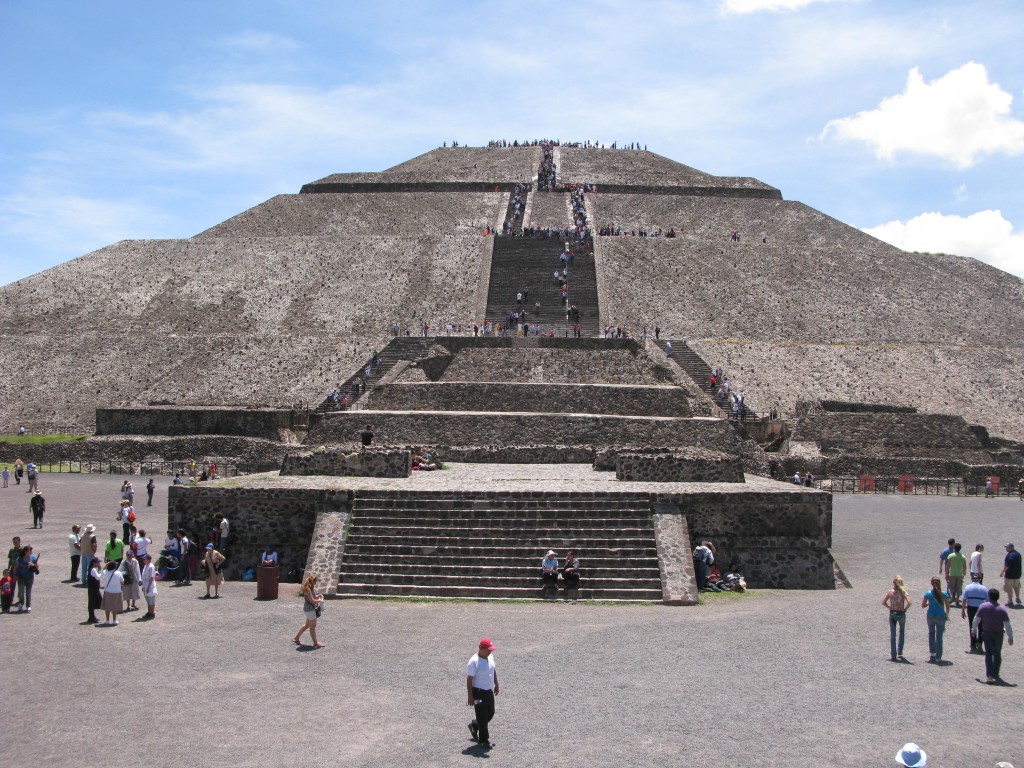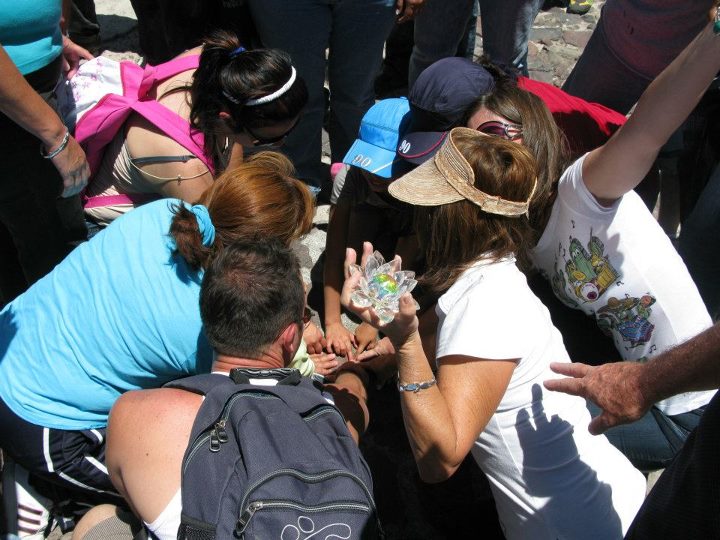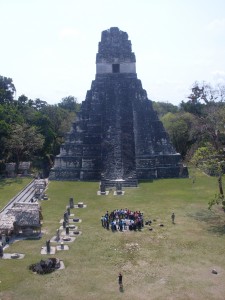 The Pyramid of the Sun in Teotihuacán is not the biggest monument you can imagine. In fact, it’s dwarfed by the hills around it that it is meant to reflect. It’s cut into four levels, each of which is about the same as a couple flights of stair in a New York apartment building.
The Pyramid of the Sun in Teotihuacán is not the biggest monument you can imagine. In fact, it’s dwarfed by the hills around it that it is meant to reflect. It’s cut into four levels, each of which is about the same as a couple flights of stair in a New York apartment building.
But at 7,500 feet, any climb can be rough. The view at the top is totally worth it – something unlike any other monument on Earth. No, not the graceful sloping of the topography or the precision lines of a long-dead culture. No, what catches is eye is the endless stream of crystal-clutching hippies clustered around the center point.
Every day, the ancient city just north of Mexico City sees hundreds or thousands of tourists belonging to two camps. One (my camp) is fascinated by an enigmatic dead empire and also wants a shot of the pyramids so astounding all their friends will comment on Facebook. The other hopes to channel the power of the ancients using $5 crystals bought at the bottom of the pyramid
“Could you feel it? I could totally feel it,” said one happy customer the day I was there.
 This phenomenon is most pronounced at the solstices and equinoxes – when the power of the ancients is apparently the strongest. I have not been yet, but I am told it’s a festive cross between group séance and Burning Man. This year, being the year that the Maya supposedly predicted the end of the world, officials are bracing for record numbers of crystal-wielders.
This phenomenon is most pronounced at the solstices and equinoxes – when the power of the ancients is apparently the strongest. I have not been yet, but I am told it’s a festive cross between group séance and Burning Man. This year, being the year that the Maya supposedly predicted the end of the world, officials are bracing for record numbers of crystal-wielders.
But here’s the funny part. Teotihuacán isn’t Maya – it isn’t even Aztec.
This whole business with the end of the world is just one big lesson in bad history lessons. The Maya (please don’t call them Mayan – that’s just their language) began a few hundred years before Christ, peaked a few hundred years after Rome declined, and declined in the 900s, about the time the Vikings were running havoc in Europe. They were obsessed with dates and were really good at mixing calendars in order to count thousands of years in the future.
The Aztecs started up around the time Notre Dame was being built and ended rather suddenly in 1521 when they met a guy named Hernán Cortés, who conquered Tenochtitlán (the largest city in the world at the time, not to be confused with Teotihuacán, by then an ancient ruin) and renamed it Mexico City. The Aztecs were obsessed with the end of the world and regularly tossed bloody corpses off pyramids to avoid it. Undoubtedly they would have thought 2012 was the end of the world. Except they had no concept of 2012. Unlike the Maya, they did not count long; 1978, 1878, and 1478 would have been roughly the same thing.
Oh, and they weren’t called the Aztecs. They were, in fact, forbidden from calling themselves Aztecs after they left the mythical city of Azlan. They were called Mexica (meh-SHE-kah).
So the Mexica didn’t have “long count” and the Maya didn’t believe in the end of the world. And they lived 600 years apart. And as for the Teotihuacán people (sorry, they did not leave us their name), no one knows, since they didn’t really write much down. The Maya knew them, since they lived at the same time but they didn’t say much beyond that they were good fighters. The Mexica knew nothing of them, but visited their ruins for the same reason we do – they are totally awesome.
So what are we to make of people that travel thousands of miles to channel the power ancients with pieces of pretty glass? Sure, it’s fun to make fun of nut jobs who, the day I was there, couldn’t even find the exact center of the pyramid. But less funny is the exotification of an indigenous people. Can you imagine someone trying to channel the wisdom of the Romans with incense in the Coliseum? Or touching the soul of Vikings by dancing around in one of those horn hemets? Yet in many ways the Maya and Mexica cultures were more advanced than these (the Maya invented the concept of zero, while the Romans had to borrow it from Asia). Trying to pretend that Ancient Mesoamericans had mystical powers colors over the very real history of how they lived.
More than that, it muddies the water of the indigenous people still grappling with how to honor their ancient culture in a modern world. Don’t forget, when the Spanish conquered the New World they did their darndest to obliterate all pagan religions. Essentially they burned all the books that people today would read to understand what those religions thought, leaving us to glean what we can from statuettes and reliefs of angry monsters.
 Their descendants have to find their own way through their history. When I visited Tikal in Northern Guatemala, there was a group of modern Maya holding a ceremony around a fire under the Jaguar Temple (for Star Wars fans, that’s the rebel base at the end of Episode 4). Anthropologists working in the area tell me there was no such ceremony during era of the Classic Maya and that fires would likely have been forbidden in such a sacred place. But cobbling together the remnants of a culture after centuries of practicing in the periphery is a tough thing to do and I am pretty sure modern Maya and Mexica would prefer to see it without foreign lenses.
Their descendants have to find their own way through their history. When I visited Tikal in Northern Guatemala, there was a group of modern Maya holding a ceremony around a fire under the Jaguar Temple (for Star Wars fans, that’s the rebel base at the end of Episode 4). Anthropologists working in the area tell me there was no such ceremony during era of the Classic Maya and that fires would likely have been forbidden in such a sacred place. But cobbling together the remnants of a culture after centuries of practicing in the periphery is a tough thing to do and I am pretty sure modern Maya and Mexica would prefer to see it without foreign lenses.
In short, the world is not going to end in 2012. The Maya didn’t think so and the Aztec didn’t either. Of course, it’s always possible that I am wrong about all of this. Worst case scenario: Despite the work of thousands of geniuses, the Large Hadron Collider opens up a black hole in Switzerland that instantaneously consumes the planet. If that happens midnight of December 21, two totally different groups of cranks will take that final moment to issue a global “I told you so.”
____________
Erik Vance is a science writer who lives in Mexico. His last LWON post was about prehensile penises. He thinks the coolest part of Mesoamerican architecture is that buildings were built over other buildings, so buildings were nested like Russian dolls — the idea being that even if you couldn’t see them, they were still there.
Photo credits:
Pyramid of the Sun in Teotihuacán, hippies, and the jaguar temple in Guatemala (people gathered at the bottom are a mix of indigenous people and tourists), all by Erik Vance
Interesting read, I’ve always been fascinated with the maya and how they evidently disappeared of the planet. Here’s an interesting thought.. wouldn’t you rather have the whole world end than to just die a lonely death? I think this is what gets people fascinated with the “end of the world” because frankly, I don’t think anybody wants to die alone. The idea of having everyone else die with you makes everything in this life so much accepting.
I enjoyed this piece, despite the unscientific use of the term “hippie.” As an aging hippie who has never held a crystal in her life (except for one visit to a store selling geologic specimens) i don’t consider “hippie,” “New Ager” and “nut job” to be synonyms any more than “Maya,” “Aztec” and “artist-warriors of Teotihuacan.” By the way, if you can recommend any further reading on Teotihuacan, I’d love to know more. I saw an exhibit of that culture’s artwork many years ago and was fascinated.
Minor quibble but since you seem to be concerned with getting other things right: Vikings never actually wore horned helmets.
Oh, snap, Paul! You got me. You know, I actually knew that in the recesses of my brain. Seeing as though I am of Norwegian descent, I should know better. Still, horned hats would be just as misplaced, since I don’t think the Mexica or the people of Teotihuacán used crystals.
I don’t have to imagine people trying to reconstruct and follow Norse and Roman religions. I have known several people who did precisely that. There are many flavours of European religious revivalists. Equally strange that they need the validation of history for their beliefs. One commenter remarked that Wiccans get very upset or go into denial if you point out that their religion is younger than the National Health Service.
I, too, am an old hippy but not a new ager and only slightly nutty.
I really liked your article and the way it’s written
They may not have used “crystals” but they definitely used ceremonial obsidian blades, the oldest artifacts in the Americas are obsidian points and blades. The points have hunting and warfare uses, a biface has little useful value except as ceremonial, decorative, or wealth status. Some archaeologists have theorized that bifaces could be blanks, but findings at quarries show that the preferred blank shape was more of a disc.
Also as a nutty hippie I take offense in being categorized with crystal-heads. (Crystal-heads have nothing to do with crystal meth, although some crystal-heads are meth-heads…)
I talked to a Maya archaeologist a while back who made some startling discoveries. A group of Maya priests came not long after to see his finds. It was a minor crisis, because a white outsider found something that deeply affected their religion. After some discussion, they decided he was sent by the gods and his finds were therefore legitimate. No real point here, except to say that reconstructing your cultural heritage can be very tricky.